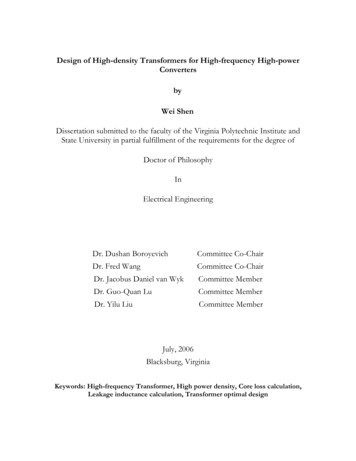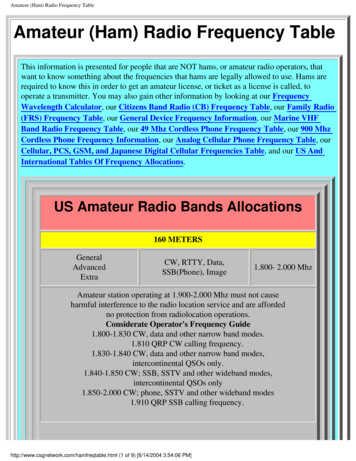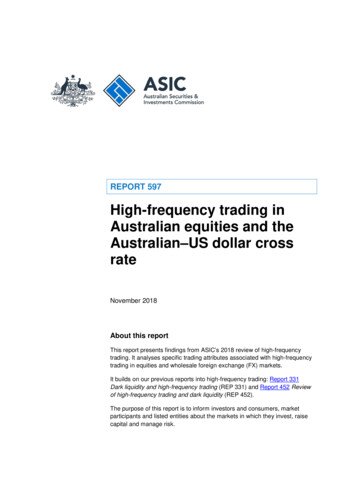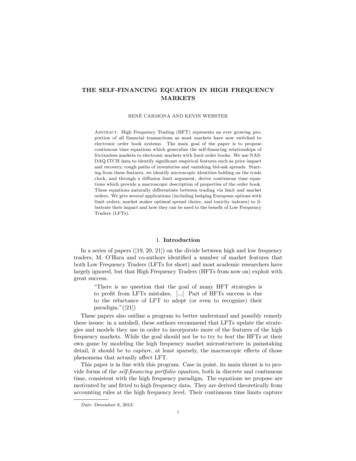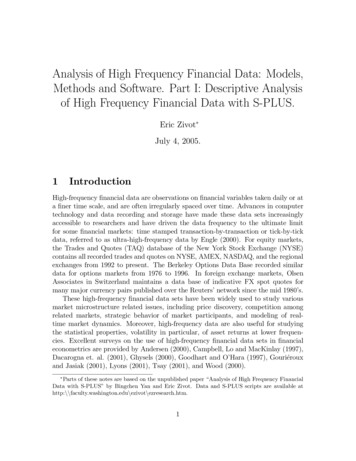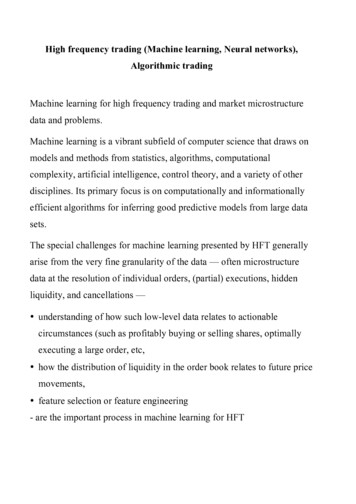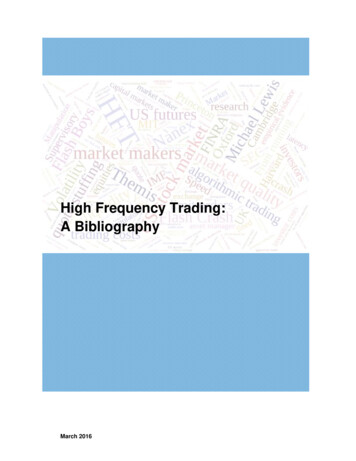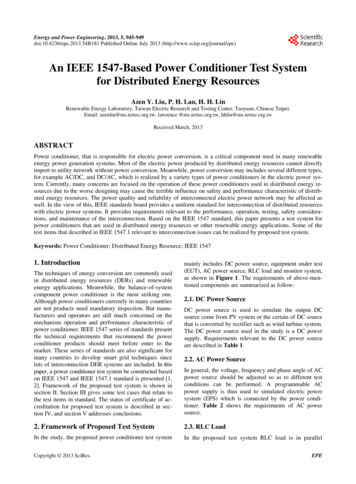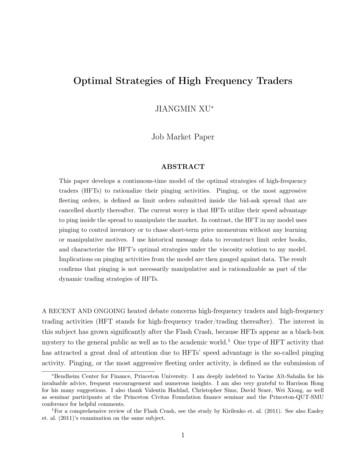
Transcription
Optimal Strategies of High Frequency TradersJIANGMIN XU Job Market PaperABSTRACTThis paper develops a continuous-time model of the optimal strategies of high-frequencytraders (HFTs) to rationalize their pinging activities. Pinging, or the most aggressivefleeting orders, is defined as limit orders submitted inside the bid-ask spread that arecancelled shortly thereafter. The current worry is that HFTs utilize their speed advantageto ping inside the spread to manipulate the market. In contrast, the HFT in my model usespinging to control inventory or to chase short-term price momentum without any learningor manipulative motives. I use historical message data to reconstruct limit order books,and characterize the HFT’s optimal strategies under the viscosity solution to my model.Implications on pinging activities from the model are then gauged against data. The resultconfirms that pinging is not necessarily manipulative and is rationalizable as part of thedynamic trading strategies of HFTs.A RECENT AND ONGOING heated debate concerns high-frequency traders and high-frequencytrading activities (HFT stands for high-frequency trader/trading thereafter). The interest inthis subject has grown significantly after the Flash Crash, because HFTs appear as a black-boxmystery to the general public as well as to the academic world.1 One type of HFT activity thathas attracted a great deal of attention due to HFTs’ speed advantage is the so-called pingingactivity. Pinging, or the most aggressive fleeting order activity, is defined as the submission of Bendheim Center for Finance, Princeton University. I am deeply indebted to Yacine Aït-Sahalia for hisinvaluable advice, frequent encouragement and numerous insights. I am also very grateful to Harrison Hongfor his many suggestions. I also thank Valentin Haddad, Christopher Sims, David Sraer, Wei Xiong, as wellas seminar participants at the Princeton Civitas Foundation finance seminar and the Princeton-QUT-SMUconference for helpful comments.1For a comprehensive review of the Flash Crash, see the study by Kirilenko et. al. (2011). See also Easleyet. al. (2011)’s examination on the same subject.1
2Jiangmin Xulimit orders inside the bid-ask spread that get cancelled very shortly.2 These activities occurin the scale of seconds or milliseconds with extremely low latency, which is “the hallmark ofproprietary trading by HFTs” (Hasbrouck and Saar (2013)).3Regulators have expressed concerns over such pinging activities, the main one being thatpinging used by HFTs might be manipulative. As pointed out in a concept release of theSecurities and Exchange Commission (SEC), HFTs could use pinging orders to detect andlearn about hidden orders inside the spread. Hidden orders are limit orders completely nonobservable to other market participants. They have become increasingly popular in the past5 to 10 years and are allowed by many stock exchanges around the world nowadays.4 Thislearning would enable HFTs to ascertain the existence of potential large trading interest in themarket. Consequently, they would be able to trade ahead and capture a price movement in thedirection of the large trading interest.5This paper aims to rationalize the pinging activity levels observable in the data through atheoretical setup without manipulative elements. It develops a continuous-time model of theoptimal trading strategies of HFTs absent any learning or strategic feedback effects. The modelexploits two well-known forces in the existing literature: inventory control (e.g. Holl and Stoll(1981)) and trend chasing (e.g. Hirschey (2013)).To achieve my purpose, I first incorporate the existence of hidden orders inside the bid-askspread into a continuous-time model along the lines of Ho and Stoll (1981). As a result, theHFT in my model would ping for hidden orders inside the spread as a cheaper way to controlhis inventory compared to using market orders. This would produce pinging orders that executeagainst hidden orders. However, with inventory control as the sole motive for pinging, it is notpossible to obtain a large number of cancelled pinging orders at the same time. The reason isthat when the HFT uses pinging to control his inventory, he intends to fill his pinging ordersand is not incentivized to cancel many of them.In order to resolve this problem, I then introduce short-term price momentum into the modelas a channel for cancelled pinging orders to occur. The momentum is modelled through thepredictability of depth imbalance on the direction of price movements. When the HFT sees large2Existing studies (e.g. Hasbrouck and Saar (2009)) have used the term “fleeting orders” to denote submissionsand subsequent quick cancellations of limit orders in general. Therefore, to be consistent with the literature, Iuse the term “pinging” throughout this paper to denote the most aggressive fleeting order activities, i.e. fleetingorders that take place inside the bid-ask spread.3To give a illustration of the speed with which pinging takes place, Hautsch and Huang (2011) find that themedian cancellation time is below one second for limit orders submitted inside the spread on NASDAQ.4According to Hautsch and Huang (2012), on average over 20% of trades on NASDAQ are executed againsthidden orders in October 2010.5SEC concept release on equity market structure, January 21, 2010.
Optimal Strategies of High Frequency Traders3depth imbalance and anticipates a likely directional price move, he could use pinging orders asdirectional bets to chase the price momentum. Moreover, if there is a subsequent large changein depth imbalance, the HFT would cancel his pinging orders and adjust his strategy accordingto the variation in momentum. Therefore, the model will now give rise to pinging as well ascancellation due to the HFT’s momentum-chasing behaviors.The model is solved numerically due to its complexity, and I use historical order book messagefeed data from NASDAQ to reconstruct limit order books and estimate model parameters.6 Theoptimal HFT strategies are characterized based on the viscosity solution to my model and theparameter estimates. There are two main findings. First, for stocks whose order books have highdepths with relatively stable movements and whose spreads tend to be narrow, approximately20% of the HFT’s optimal strategies are attributable to pinging. On the other hand, for stocksthat tend to have low order-book depths, volatile order-book movements and wide spreads,pinging accounts for nearly 50% of the HFT’s optimal strategies. These pinging percentagesfrom the model are proven to match most of the observable pinging activity levels from thedata. Thus it implies that the pinging activities occurred in reality can be mostly rationalizedby my model without any learning or manipulative components. Second, I demonstrate thatthe mechanism of momentum chasing plays a much more important role than that of inventorycontrol in rationalizing pinging activities for low-depth and wide-spread stocks. In contrast, thetwo mechanisms carry around similar weights in rationalizing pinging activities for high-depthand narrow-spread stocks. Furthermore, both mechanisms are shown to be necessary for themodel to rationalize the pinging occurrences found in the data.Beyond pinging rationalization, my model also generates a couple of additional auxiliarypredictions. They concern about the directions of pinging activities and the frequencies ofcancelled pinging activities with regard to the depth imbalance of order books. These predictionsare also found to be largely consistent with the data, which further suggests that pinging isrationalizable as part of the dynamic trading strategies of HFTs.In what follows, I build a continuous-time, partial equilibrium model that captures a widerange of HFT strategies and explore their empirical content and implications. I begin in SectionI by discussing the relations between my model and the existing literature. Section II lays outthe structure of my model. The model’s equilibrium and my numerical solution are presentedin Section III. Section IV is devoted to parameter estimations. I then discuss the main findingsof this paper in Section V, and draw out the model’s auxiliary predictions and evaluate themon empirical data. Finally, Section VI concludes.6I am grateful to NASDAQ for providing me with the access to their historical TotalView-ITCH real-timelimit order book message feed database.
4Jiangmin XuI. Related LiteratureThere is a long line of empirical studies (see, e.g., Brogaard et. al. (2013a), Brogaard et. al.(2013b), Hagströmer and Nordén (2013), Hasbrouck and Saar (2013), Hendershott and Riordan(2013), Hendershott et. al. (2011) and Menkveld (2013)) that have tried to understand the effectsof high-frequency and algorithmic trading activities on market quality. This line of research iseconomically important as HFT firms account for over 50% of all US equity trading volume in2012.7On one hand, the majority of the empirical studies show that, on balance, HFTs are beneficial for market quality. For instance, Brogaard et. al. (2013b) find that HFTs enhance pricediscovery and market efficiency on NASDAQ, with prices reflecting information more quickly.Hasbrouck and Saar (2013) also show that increased HFTs’ low-latency activities are associatedwith lower posted and effective spreads, lower short-term volatility and increased market depth.Additionally, Hendershott et. al. (2011) illustrate that algorithmic tradings improve liquidityand make quotes more informative for NYSE stocks.On the other hand, there are empirical analyses demonstrating that some of the HFT strategies are speculative/anticipatory in nature. For example, Hirschey (2013) finds that HFTs onNASDAQ tend to anticipate future order flow and trade ahead of it, through aggressively takingliquidity from the market. Moreover, Kirilenko et. al. (2011) show that HFTs exacerbated market volatility during the Flash Crash by trading in the direction of the downward price spiral.In addition, Baron et. al. (2012) find that aggressive, liquidity-taking HFTs earn short termprofits at the expense of other market participants.This paper focuses on the optimal trading strategies of HFTs and their pinging activities inparticular. It builds on the work of Holl and Stoll (1981) – HS81, Avellaneda and Stoikov (2008)– AS08, and Guilbaud and Pham (2013) – GP13. HS81 first introduced, in a continuous-timepartial equilibrium model, a market maker who optimally chooses the bid and ask prices of hislimit orders to maximize his expected utility of (terminal) wealth. The market maker uses limitorders only, so that inventory can only be managed through limit orders. AS08 recast HS81 ina modern HFT setting by introducing the trading environment for HFTs not present in HS81– the limit order book. However, an HFT in AS08 is still a pure market maker, since he usesonly limit orders to maximize his utility and control his inventory.GP13 brought in market orders to the framework of HS81 and AS08. In their model, anHFT can trade via both limit orders and market orders. The HFT can post limit orders atthe best quotes or improve the quotes by one tick. Otherwise he can use market orders instead7Times Topics: High-Frequency Trading, The New York Times, December 20, 2012.
Optimal Strategies of High Frequency Traders5to change his inventory instantaneously. The purpose of introducing market orders as anothercontrol mechanism is to better address the execution risk and the inventory risk faced by HFTswhen they use limit orders only.My model extends the continuous-time configuration of GP13 for HFTs and makes two contributions. Firstly, hidden orders are introduced into the limit order book, which are not presentin either AS08 or GP13. Hence the HFT can ping for hidden liquidity when his limit ordersimprove the best bid/ask prices and are submitted inside the spread. This captures the ideaof pinging strategies as identified in Hasbrouck and Saar (2009)’s empirical study. Secondly, Imodel the order book’s depth imbalance at the best quotes as a stochastic process that has aneffect on the movement of the mid-prices and on the existence of hidden orders. Thus the HFTcan use the depth imbalance as a (imperfect) signal to anticipate the likely price movement.Therefore, the HFT will utilize pinging or market orders to conduct directional/momentum tradings when necessary. This captures the idea of anticipatory strategies as identified in Hirschey(2013), which is not modelled explicitly in GP13.Due to market orders being impulse (jump) controls in continuous time, the value functionof the HFT in my model is not necessarily smooth and differentiable everywhere. Consequently,I will apply the viscosity solution technique to my model, which is similar to the one used inGP13.8 The viscosity solution concept, originally introduced by Crandall and Lions (1983), is ageneralization of the classical solution concept to Hamilton-Jacobi-Bellman equations (or partialdifferential equations in general) where value functions might not be everywhere differentiable.I will discuss the setup of my model and its solution in detail in the next two sections.II. The ModelThe economy is defined in a continuous time, finite horizon T [0, T ], with a single riskystock that can be traded in a limit order book (LOB). There is a high-frequency trader (HFT)who trades this stock using either limit orders or market orders. The LOB has a tick size δ, sothat prices of all orders are in multiples of δ. Characteristics of the LOB, such as spread andmid-price, evolve stochastically and are exogenous to the HFT.9 The formalization of my modelis further specified as follows.8HS81 and AS08 consider only limit orders that are regular (continuous) controls in continuous time. Therefore, the value functions of HFTs in their models are smooth and differentiable at every point, so that they havestandard Hamilton-Jacobi-Bellman equations and classical solution techniques apply.9A limit order of size q at price p is an order to buy or sell q units of the asset at the specified price p; itsexecution occurs only when it meets a counterpart market order. A market order of size q is an order to buyor sell q units of the asset being traded at the lowest (for buy) or the highest (for sell) available price in themarket; its execution is immediate. Given an asset, the best bid (resp. ask) price is the highest (resp. lowest)
6Jiangmin XuA. Processes of Limit Order Book CharacteristicsTo introduce the main characteristics of the LOB, I will fix a filtered probability space(Ω, O, O, P), O (Ot )t 0 satisfying the usual conditions. Therefore, all stochastic processesand random variables are defined on (Ω, O, O, P).To start with, the depth imbalance F at the best quotes is defined to be the difference ofthe log of the size of the depth at the best bid price from that at the best ask price, so thatF ( )0 means bid (ask) side imbalance. It follows an Ornstein-Uhlenbeck process with meanzero:dFt αF Ft dt σF dWt ,(2.1)where αF measures the speed of mean-reversion and σF is a constant volatility parameter.Next, letS {St }t 0(2.2)denote the bid-ask spread of the LOB. It follows a continuous time Markov chain on the statespace S {δ, 2δ, 3δ}, with a constant jump intensity λS representing the times when orders ofparticipants in the market affect the spread. The probability transition matrix of S is denotedby ρ (ρij )1 i,j 3 , with ρii 0.Furthermore, the mid-price P of the stock is assumed to evolve according to a pure jumpprocess:dPt dJ1t dJ2t .(2.3)The first component, J1t , has a constant jump intensity λJ1 , and jump sizes equal to δ/2 withprobability ψ1 (Ft ) and δ/2 with probability 1 ψ1 (Ft ); while the second component, J2t , hasa constant jump intensity λJ2 , and jump sizes equal to δ with probability ψ2 (Ft ) and δ withprobability 1 ψ2 (Ft ), where the functions ψi : R 7 [0, 1] are assumed to have the formψi (u) 1/(1 exp( βi u)), for i 1, 2 ,with βi being positive constants. In addition, J1 and J2 are independent.10 I allow the depthimbalance F to have an impact on the directions of mid-price jumps, since HFTs mostly seekinformation from the LOB itself to forecast price movements in the millisecond environment.price among all active buy (resp. to sell) limit orders in the order book. The spread is the difference betweenthe best ask price and the best bid price, which is strictly positive. The mid-price is the mid-point between thebest bid and the best ask price. For a more detailed explanation of limit order book variables, please refer tothe non-technical survey of Gould et. al. (2010).10The best bid and best ask prices are thus Pt St /2 and Pt St /2 respectively.
Optimal Strategies of High Frequency Traders7Depth imbalances capture liquidity pressures within the LOB. Therefore, it is informative aboutat which side of the book the observable depth is likely to become depleted first, resulting ina change in the mid-price. Hence it is a natural signal (albeit imperfect) for the HFTs to inferthe direction of future price movements, based on the current state of the LOB.The influence of the depth imbalance F on the directions of the mid-price jumps is interpretedas the short-term price momentum in the model. If the parameter σF is large so that F is volatile,it leads to more frequent appearances of stronger momentum (signals). Thus the HFT wouldbe more likely to engage in trend-chasing actions. This effect is amplified if the jump intensitiesλJ1 and λJ2 of the mid-price are higher, i.e. there are more realizations of price momentum.Besides these standard LOB characteristic variables, orders with limited pre-trade transparency have become increasingly popular on electronic trading platforms recently. Major USstock exchanges, such as NASDAQ, NYSE and BATS, permit submissions of hidden limit orders into their LOBs.11 The price, size and location of these orders are completely concealedfrom other market participants, and they can be placed inside of the observable bid-ask spreadwithout affecting the visible best bid and ask quotes. This interesting mechanism of hiddenorders has created a vast number of order activities in markets as HFTs try to “ping” for hiddenliquidity inside of the spread by posting aggressive “fleeting orders” that are cancelled a fewinstants later if not executed.12Consequently, to account for this important phenomenon, I will specify the existence ofhidden orders in the following fashion. If the spread St equals 2δ, the probability of hiddenbid orders sitting at the mid-price Pt is ϕ1 (Ft ) and the probability of hidden ask orders isπ1 ϕ1 (Ft ). Similarly, if St 3δ, the probabilities of hidden bid orders at Pt δ/2 and P δ/2are ϕ1 (Ft ) and ϕ2 (Ft ) respectively, so that those of hidden ask orders at Pt δ/2 and Pt δ/2are π1 ϕ1 (Ft ) and π2 ϕ2 (Ft ). Since existing literature suggests that the probability of hiddenorders inside the spread is positively correlated with the own-side depth imbalance,13 I let thefunctions ϕi take the form ofϕi (u) πi /(1 exp( κ u)), for i 1, 2 ,where κ and πi are positive constant and πi 1. When π1 and π2 are large, hidden orders are11Hautsch and Huang (2012) give a detailed empirical analysis of hidden orders on Nasdaq stocks. They findthat, during the month of October 2010, on average, 20.1% of all trades are executed against hidden orders.However, only a small proportion of the hidden depth get executed, which implies that the share of undetectedhidden depth is much greater.12This pinging phenomenon was first documented in Hasbrouck and Saar (2009).13Buti and Rindi (2013) provide a theoretical model that gives rise to this positive correlation, and Hautschand Huang (2012) offer an empirical confirmation.
8Jiangmin Xumore likely to be found within the spread. Thus the HFT would have more opportunities totake advantage of these hidden orders through the use of pinging orders.B. The HFT’s Trading StrategyAt any time t, the HFT in my model can submit limit buy and sell orders specifying theprices that he is willing to pay and receive, but they will be executed only when incomingmarket orders fill his limit orders. The quantity of the HFT’s limit orders is fixed at one lot(100 shares).14 On the other hand, instead of limit orders, the HFT can send out market buyor sell orders for immediate execution. The market orders will cross the spread, i.e. trading atthe best ask (resp. best bid) price on the opposite side, and are thus less price-favorable.B.1. Make Strategy.When using limit orders to make the market, HFT can place his quotes at the best availablebid and ask, hence joining the existing queues at these prices.15 This strategy simply amountsto traditional market making, which means that the HFT tries to passively capture the spreadby posting limit orders at the best available quotes.Furthermore, the HFT can also “ping” inside the spread by improving either the best bid orask price by one tick whenever the spread St is greater than δ, i.e. submitting a buy (sell) limitorder at Pt St /2 δ (Pt St /2 δ). Such a pinging strategy of putting limit orders insidethe spread is commonly used by HFTs in practice to capture the market order flow at the bestquotes, because of the price-time priority associated with these limit orders. More importantly,they are used to ping for hidden orders inside the spread, as identified by Hasbrouck and Saar(2009). Nevertheless, despite being able to obtain faster executions, these pinging limit ordersdo receive worse execution prices than their queuing counterpart. Hence this is a trade-off facedby the HFT when he contemplates whether to improve the spread or not.Because the submission, update or cancellation of limit orders entails no cost, it is naturalto model the make strategy of the HFT as a continuous-time predictable control process:θtmk {θtmk,b , θtmk,a } , t 0,14The reason that I fix the quantity of limit orders to be one lot is motivated by a common finding thatappears in a vast number of empirical studies, whether they examine HFT activities (e.g. Hasbrouck and Saar(2013)) or analyze limit order books (e.g. Hautsch and Huang (2012)). The finding is that the average size oflimit orders nowadays is just slightly bigger than 100 shares.15I define market making to be the strategy such that the HFT submit limit orders simultaneously at bothsides of the LOB. Quoting at one side of the book only is not allowed, since it does not satisfy the standarddefinition of market making.
Optimal Strategies of High Frequency Traders9where θtmk,b {0, 1} and θtmk,a {0, 1}. b, a stand for the bid and the ask side respectively.The predictable processes θtmk,b and θtmk,b , with values equal to 0 or 1, represent the possiblemake regimes: 0 indicates that the limit order is joining the queue at the best price, whereas1 indicates improving the best price by δ. Note that if the spread is at its minimum δ, θtmk,band θtmk,b both can only take the value of 0, since improving the best bid/ask will simply beconsidered as posting a market buy/sell order instead.B.2. Take Strategy.Instead of limit orders, the HFT may also employ market orders (take strategy) to obtaininstant execution. However, unlike limit orders, market orders take liquidity from the LOB andare subject to transaction fees. As a result, the costly nature of market orders implies that, ifthe take strategy is performed continuously, the HFT will go bankrupt in finite time. Hence Ishall model the HFT’s take strategy as an impulse control in continuous time:θtk {τn , ζn }n N .Here, {τn } is an increasing sequence of stopping times denoting the moments that the HFT usesmarket orders. ζn [ ζmax , ζmax ]\{0} are Fτn -measurable random variables that represent thenumber of shares (in lot size) purchased if ζn 0 or sold if ζn 0, at these stopping times. Iconfine the size of market orders to be less than or equal to some small constant ζmax , so thatthe HFT remains small relative to the market and his market orders do not eat through theLOB.16C. Order Execution ProcessesLimit orders of the HFT, when joining the queue at the best bid and ask, will be executedonly if counterpart market orders arrive in the next instant and their sizes are large enough tofill the HFT’s limit orders completely. I model the arrivals of exogenous buy and sell marketorders by two independent Poisson processes, M b and M a , with intensities given by λb and λarespectively. In addition, when a buy (resp. sell) market order arrives, the HFT’s sell (resp.buy) limit order in the queue will be filled with a probability given by the fill-rate function h(Ft )(resp. h( Ft )), where16Eating through the book means the size of an market order is larger than and thus exhausts the availabledepth at the best price(s), resulting in a price impact and a widening of the spread.
10Jiangmin Xuh(u) 1/(1 exp(ς0 ς1 u)), ς0 , ς1 are positive constants.This fill-rate function depicts the idea that the probability of execution of a limit order becomeshigher/lower if the own-side queue is relatively shorter/longer, which illustrates the time prioritystructure of the LOB.However, if an limit order jumps the queue instead, it will receive an instantaneous executionas long as there is a matching hidden order on the opposite side that resides inside the spread.Otherwise, the limit order will be fully matched if a counterpart market order arrives at thenext moment. Limit orders placed inside the spread by the HFT are not subject to the fill ratefunction, since they have price priority compared to those limit orders at the prevailing bestquotes.Turning to the HFT’s market orders, they will execute immediately by hitting either insidespread hidden orders or limit orders at the best quote on the opposite side. Moreover, there isa per share fee of associated with each market order that is sent by the HFT. The fee is fixedand paid directly to the market exchange operating the LOB. Thus the HFT cannot claim itback by any means.D. Comments on the ModelThe basic layout of the model resembles Guilband and Pham (2013) and is easy to justifygiven the goals of the paper. However, there are two important aspects of the model that arenew compared to the current literature on high-frequency trading strategies and are essential forrationalizing HFTs’ pinging activities without manipulation or learning. First, the opportunityof using limit orders to grasp hidden liquidity has not been properly addressed in existingcontinuous-time models of HFTs, where the limit order strategy only fulfills the role of theHFT as a traditional market maker or liquidity provider. In my model, limit orders can alsobe utilized by the HFT as a “pinging” strategy, because of the existence of inside-spread hiddenorders. Compared to conventional market making, pinging is certainly more aggressive as itseeks a faster execution at a less favorable price. However, it is not as aggressive as markettaking since it does not cross the spread. Given the large number of pinging activities alreadyidentified in empirical work, for example, Hasbrouck and Saar (2009, 2013), it is essential toinclude hidden orders and pinging strategies in a theoretical model of HFT behaviors.Another aspect that has not been fully dealt with in the continuous-time literature concernsthe prospect of directional or momentum tradings by the HFT. In a standard setup, the HFTwould only use market orders to reduce its inventory whenever it gets out of control. However, in
Optimal Strategies of High Frequency Traders11my model, the HFT would also implement market orders as a momentum strategy to aggressivelytake liquidity from the market and pursue directional trading when the signal of depth imbalanceon price movement is strong enough. There are empirical studies that have identified some mostprofitable HFTs as predominantly liquidity takers on the market (e.g. Baron et. al. (2012)) andhave recognized the anticipatory/directional trading behaviors of HFTs (e.g. Hirschey (2013)).Therefore, it is crucial to incorporate momentum/directional trading into any theoretical modelson HFT strategies.17When both hidden orders and price momentum exist in the model, the HFT has two motivesto carry out pinging strategies. One is to control inventory. The HFT could ping inside thespread to hit hidden orders when he needs to unwind his inventory, which is cheaper than usingmarket orders. Nonetheless, if hidden orders existed with high probabilities π1 and π2 andinventory control was the HFT’s only motive for pinging, the model would generate a largenumber of pinging orders filled by hidden orders. There would not be many cancelled pingingorders at the same time, contradicting with the numerous ones observed in reality.The existence of price momentum, i.e. the predictability of depth imbalance on mid-pricejumps, are then necessary to bring about cancelled pinging activities. This is because now theother motive for the HFT to ping is to chase price trends. The HFT could employ pinging ordersto establish directional positions when anticipating likely price movements. However, if thevolatility parameter σF is large so that depth imbalance (momentum signal) varies turbulently,it would induce the HFT to cancel his pinging orders frequently and change his strategies basedon the swings in momentum. This is escalated if the mid-price jump intensities λJ1 and λJ2 arealso large. Large intensities prompt more trend-chasing pinging activities from the HFT sincehis directional bets have higher chances to materialize, yet the HFT often needs to cancel hispinging orders due to volatile changes in price momentum.As a consequence of the possibility of pinging and momentum trading, the HFT in my modelshould not be considered exclusively as a turbo-charged market maker in the traditional
Optimal Strategies of High Frequency Traders JIANGMIN XU Job Market Paper ABSTRACT This paper develops a continuous-time model of the optimal strategies of high-frequency traders (HFTs) to rationalize their pinging activities. Pinging, or the most aggressive fleeting orders, is defined as limit orders submitted inside the bid-ask spread that areCited by: 3Publish Year: 2015
